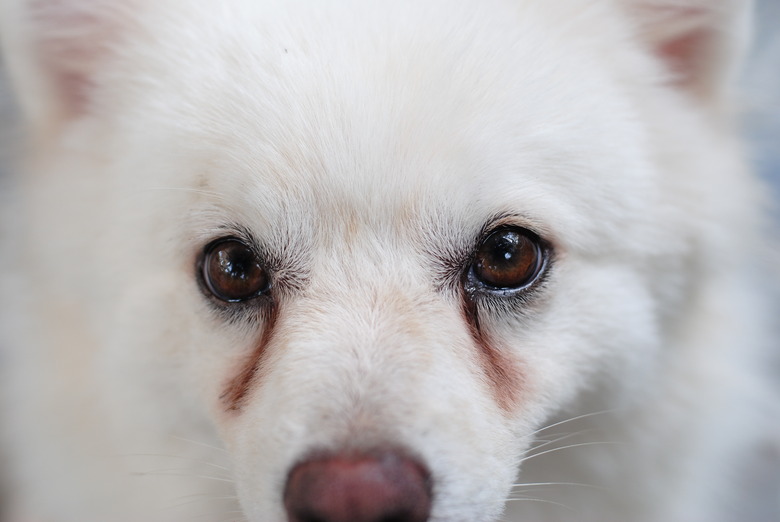How To Make A Natural Dog Tear Stain Remover
Tear stains are an all too familiar annoyance for both dogs and their people. While unsightly and uncomfortable, these reddish-brown streaks are harmless and really don't warrant a trip to the veterinarian. But it does help to understand how to remove tear stains and keep them away without using any chemicals that could harm your best friend.
Common causes of tear stains in dogs
Common causes of tear stains in dogs
Tear stains are caused by pigments, yeast and bacteria buildup. They're typically no more than a nuisance, but occasionally tear stains can be a symptom of an underlying health problem. It's important for pet parents to understand the differences between innocuous stains and warning signs.
Epiphora is an overflow of tears from the eyes, and it's the most common source of dog tear staining. Epiphora is typically caused by insufficient tear drainage due to blockage or, quite simply, too many tears — which can be caused by allergies, undiagnosed eye problems or other irritants that cause your dog's eyes to water. If your dog's tear ducts are suspected of being blocked, a veterinarian will need to flush out the contents.
Porphyrin is a pigment that is excreted in tears, saliva and urine. It contains iron from the breakdown of red blood cells and is often the reason dog tear stains are brackish in color.
Genetics can cause some breeds to be more susceptible to tear stains. In addition to the short-muzzled brachycephalic breeds like pugs — poodles, Shih Tzus, Bichon Frise and Maltese are also plagued with tear stains. Also, dogs with light-colored coats will also show tear stains more readily than their dark-coated counterparts.
Environmental peculiarities like water that is high in iron or other minerals can affect a dog's pH levels and result in tear staining that would not normally be present. The same goes for allergens like mold, pollen and dust — all known culprits that cause dogs' eyes to water more than usual.
Abnormal lashes and tear ducts can irritate the surface of the eyes, which respond by producing more tears than normal, resulting in epiphora.
Infections of the skin around the eyes causes symptoms that resemble tear stains, but are not. If the stain is brownish in color, it's possible that the stain is caused by yeasts rather than bacteria.
Other causes of tear staining include:
- Ingrown Lashes
- Glaucoma
- Inverted Eyelid (Entropion)
- Brachycephalic Syndrome
- Ear Infection
- Medications
- Exposure to Cigarette Smoke
- Poor Diet
- Stress
Common natural remedies to remove dogs' tear stains
Common natural remedies to remove dogs' tear stains
Changing the pH of a dog's tears is a common way to reduce the staining to fur surrounding the eyes. A change in tear alkalinity makes it difficult for yeast and bacteria to thrive, causing less eye irritation and fewer stains. Add a daily teaspoon of white vinegar to your dog's water bowl to suppress the frequency and severity of tear stains.
Cleaning your dog's face with colloidal silver applied to a cotton ball is an effective way to brighten stained fur. Colloidal silver is safe near your dog's eyes, and it can be purchased at any health-food store.
Daily hygiene and grooming can go a long way towards preventing the buildup of staining around a dog's eyes. Clip any long hairs to prevent matting, irritation and possible infection. Clean the eye area thoroughly and remove any crusty material with a clean towel.
How to make an all-natural tear stain remover for dogs
How to make an all-natural tear stain remover for dogs
Making your own natural tear-stain remover is not only cost-effective, a homemade solution is much healthier than the expensive, over-the-counter options — many of which have been banned, recalled and placed on a watch list by the FDA.
What you'll need: distilled water, salt and liquid vitamin C.
Instructions: Mix a teaspoon of salt and 1-3 drops of vitamin C with two cups of distilled water. Be sure to use distilled water so that you can control the pH level of your eye solution. Place the solution on a cotton ball to clean your dog's face and lighten the tear stains that have already formed.
The citric acid will oxidize the iron-based pigments that cause the rust-colored stains. Liquid vitamin C can be substituted with an eyewash that contains small amounts of boric acid.
Bottom line
Bottom line
For the most part, tear stains are purely a cosmetic problem that do not really need to be treated. While homemade tear-stain removers can treat the visible staining on your dog's face — factors like diet, allergies, water pH, and regular cleaning and grooming can prevent tear stains from forming in the first place. When dealing with tear-stain removal, avoid using products intended for humans like TUMs and commercially-available pet products that are under the scrutiny of the FDA.


